七年级英语上册Unit4MydayGrammar教案(新版)牛津版
- 格式:docx
- 大小:21.47 KB
- 文档页数:4
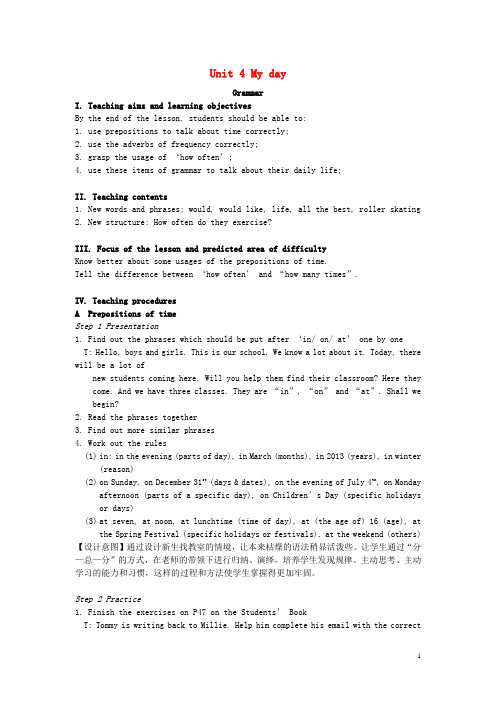
Unit 4 My dayGrammarI. Teaching aims and learning objectivesBy the end of the lesson, students should be able to:1. use prepositions to talk about time correctly;2. use the adverbs of frequency correctly;3. grasp the usage of ‘how often’;4. use these items of grammar to talk about their daily life;II. Teaching contents1. New words and phrases: would, would like, life, all the best, roller skating2. New structure: How often do they exercise?III. Focus of the lesson and predicted area of difficultyKnow better about some usages of the prepositions of time.Tell the difference between ‘how often’ and “how many times”.IV. Teaching proceduresA Prepositions of timeStep 1 Presentation1. Find out the phrases which should be put after ‘in/ on/ at’ one by oneT: Hello, boys and girls. This is our school. We know a lot about it. Today, there will be a lot ofnew students coming here. Will you help them find their classroom? Here they come. And we have three classes. They are “in”, “on” and “at”. Shall we begin?2. Read the phrases together3. Find out more similar phrases4. Work out the rules(1)in: in the evening (parts of day), in March (months), in 2013 (years), in winter(reason)(2)on Sunday, on December 31st(days & dates), on the evening of July 4th, on Mondayafternoon (parts of a specific day), on Children’s Day (specific holidays or days)(3)at seven, at noon, at lunchtime (time of day), at (the age of) 16 (age), atthe Spring Festival (specific holidays or festivals), at the weekend (others) 【设计意图】通过设计新生找教室的情境,让本来枯燥的语法稍显活泼些。
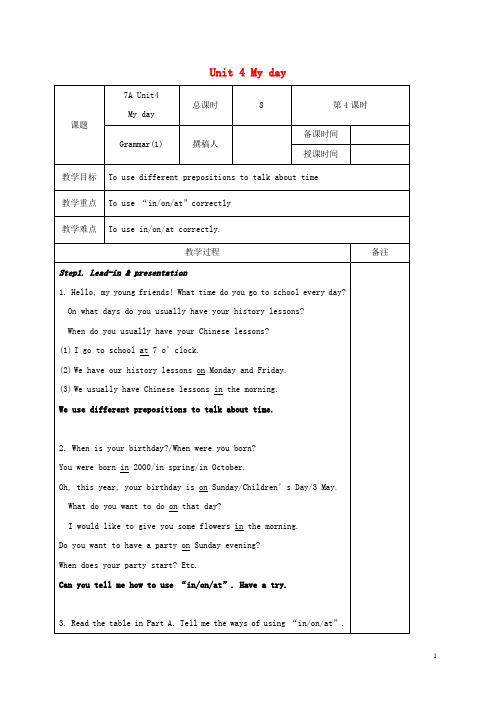
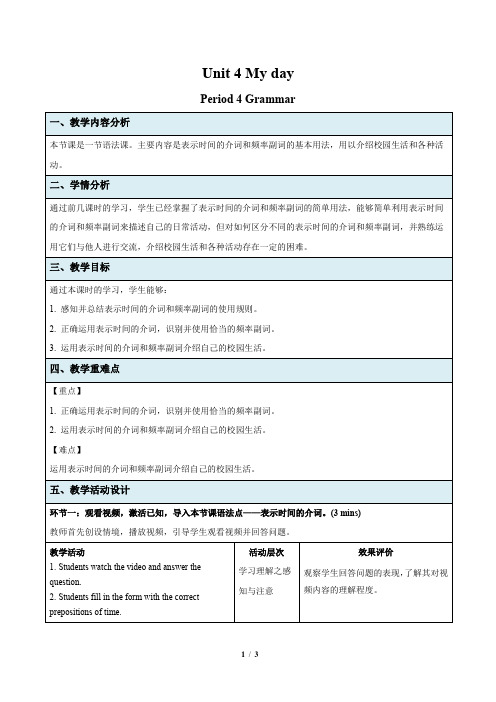

牛津译林版英语七上Unit 4《My day》(Grammar)说课稿一. 教材分析《牛津译林版英语七上Unit 4 My day》主要讲述了日常生活中的活动安排和描述。
通过本单元的学习,学生能够掌握一般现在时态的运用,学会如何用英语描述自己的日常活动。
本单元的核心语法是一般现在时,学生需要掌握其构成、用法以及与一般过去时和一般将来时的区别。
二. 学情分析七年级的学生已经初步掌握了英语的基础知识,具备一定的听、说、读、写能力。
但在此阶段,学生对英语的语法知识掌握还不够深入,需要通过大量的练习来巩固。
此外,学生的学习兴趣和积极性对英语学习成果有很大影响,因此,激发学生的学习兴趣和动机是本节课的重要任务。
三. 说教学目标1.知识目标:学生能够掌握一般现在时的构成、用法,学会用英语描述自己的日常活动。
2.能力目标:学生能够在实际情景中运用一般现在时,提高英语表达能力。
3.情感目标:培养学生热爱生活、积极向上的生活态度,增强同学间的友谊。
四. 说教学重难点1.教学重点:一般现在时的构成、用法以及与一般过去时、一般将来时的区别。
2.教学难点:一般现在时的运用,特别是在具体情境中的运用。
五. 说教学方法与手段本节课采用任务型教学法,通过各种互动活动,让学生在实际操作中掌握一般现在时的用法。
同时,运用多媒体手段,如图片、视频等,辅助教学,提高学生的学习兴趣。
六. 说教学过程1.导入:以一幅描绘日常活动的图片引导学生进行观察,激发学生对课程的兴趣。
2.呈现:通过展示一段视频,让学生了解一般现在时的用法,同时引入本节课的主题。
3.操练:设计各种任务,让学生在实际操作中运用一般现在时,如描述自己的日常活动、编写对话等。
4.巩固:通过小组活动,让学生在互动中进一步巩固一般现在时的用法。
5.拓展:引导学生运用一般现在时描述未来的计划,培养学生的创新思维。
6.总结:对本节课的内容进行归纳总结,强调一般现在时的用法。
7.作业:布置相关练习,让学生课后巩固所学知识。
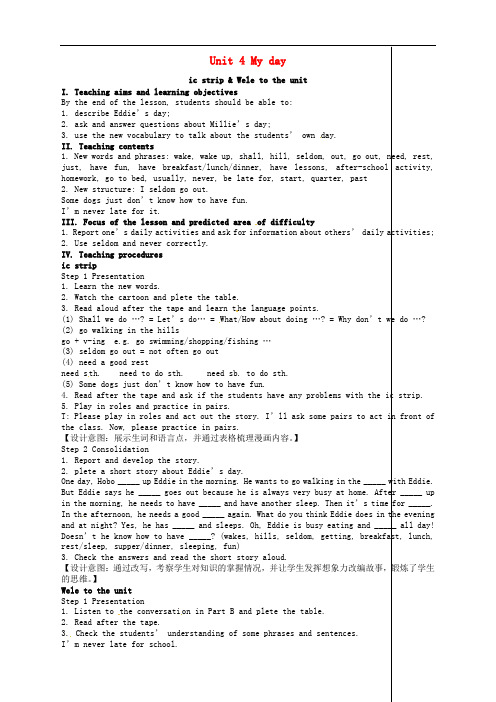
tudents’ own day.1. New words and phrases: wake, wake up, shall, hill, seldom, out, go out, need, rest, III. Focus of the lesson and predicted area3. Read aloud after the tape and learn t he language points.What/How about doing …? = Why don’t we do …? need se1. Listen to the conversati on in Part B and plete the table.start lessonsat a quarter past eightenjoy schoolT: OK, do you have any questions to ask me? “I’m never late for it.” Who can translate it into Chinese? What does “never” mean?4. Develop the conversation.【设计意图:通过书上提供的表格进行扩展练习。
】Step 2 Consolidation1. plete the passage, check the answers and read the passage aloud.T: OK, you really did a good job. Now are you clear abou t Millie’s daily activities? Please plete this short passage about Millie’s day.Millie is a hard-working student. She ______ up early in the morning. She goes to _______ at 7:20. She’s _______ late for school. Before the first lesson starts, Millie and all her classmates do morning ________. She has lunch at ten to ________. The school finishes at four ______ in the afternoon. Then it’s time for after-school ________. She always has fun. In the evening, Millie watches TV for ______ an hour. It’s her favourite time of the day. Then she needs to do her __________. She always does it carefully. She usually goes to _______ at 9:30.2. Report your day.(1) plete the table in the book abo ut the students’ own days.T: Now, I know something about Eddie’s and Millie’s days now. Next, I’d like to know about your day. Please write down the time and the activities in the table.(2) Practice reporting the students’ own da ys.T: OK, p lease try to report your day according to the table you finished just now. I’ll give you only two minutes to practice. Please try to make your report clear and interesting.(3) Ask a student to report and the other students to listen carefully.T: Time is up! Are you ready to report your day? When one student is telling about his or her day, the others should listen carefully. I will ask you questions after the report. Who’d like to be the first to tell us about your day?T: Thank … for your report. Now q uestions for the other students. Are you ready? Question 1 …【设计意图:让学生结合自己的实际情况练习,达到学以致用。
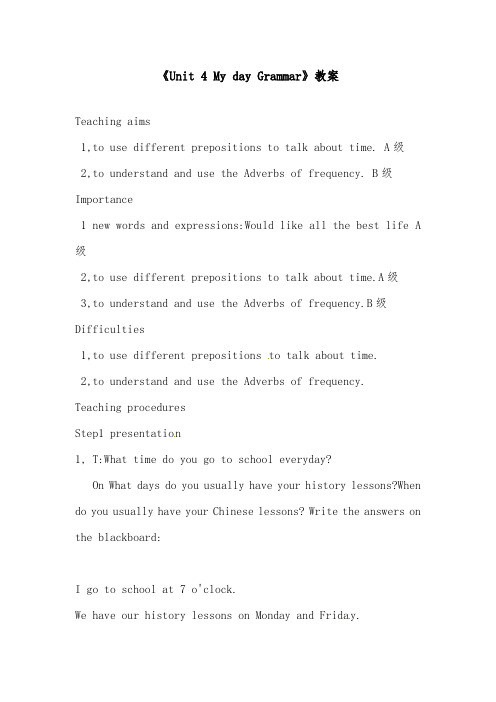
《Unit 4 My day Grammar》教案Teaching aims1,to use different prepositions to talk about time. A级2,to understand and use the Adverbs of frequency. B级Importance1 new words and expressions:Would like all the best life A 级2,to use different prepositions to talk about time.A级3,to understand and use the Adverbs of frequency.B级Difficulties1,to use different prepositions to talk about time.2,to understand and use the Adverbs of frequency. Teaching proceduresStep1 presentation1, T:What time do you go to school everyday?On What days do you usually have your history lessons?When do you usually have your Chinese lessons? Write the answers on the blackboard:I go to school at 7 o'clock.We have our history lessons on Monday and Friday.We usually have Chinese lessons in the morning.We use different prepositions to talk about time.2,let Ss think of more usage of"at on in"3,Let Ss read the table in Part A.then tell the ways of using"at on in"4,Let Ss read the examples together.Step2practise1,communicate with Ss(1)When is Children's Day?(2)What season is it in?(3) What do you do on that day?(4)When do you eat a birthday cake?(5)When do you usually chat with your classmates?(6)How old do children in your city start learning English?(7)When do you do your morning exercises?2 ,let Ss finish the exercise.(1)Eric's birthday is ___6 December.(2)The Open Day is ____ Tuesday.(3)I want to play tennis with Simon ____three o'clock ____the afternoon.(4)We have a long holiday ____October.(5)I hope my dream can come true ____25.3,Let Ss finish the E-mail on P 474,Let Ss read the E-mail ,Then check the answers together.5 ,Let Ss read the E-mail together.Step3 presentation1 Communicate with SsT:Tommy and Millie often chat with each other on the internet.Do you often chat on the Internet?How often do you write e-mails? S:...T:Oh, you chat with your friends on the internet everyday.So you always chat with your friends...\T:Adverbs of frequency tell you how often things happen. 2.Let Ss read the picture of Part B ,and work out the rule: Always-usually-often-sometimes-seldom-neverStep4 practiceLet Ss finish the exercise on P 48Let Ss read it together .and remind them of the adverbs . Step5 ActivityI'll give you some minutes to prepare the conversation about your own day.You can talk about your school day and your daily activities.Pay attention to use the correct prepositions of time and adverbs of frequency.分层效果检测题必做题A层一、用on, in和at填空。
牛津译林版七年级上册Unit 4 My day 课时4 (Grammar)教案(7A U4) My Day Grammar-----Prepositions of TimeAnalysis of teaching material:This is grammar part of unit 4. The lesson focuses on the preposition of time including in on at. These three prepositions of time are closely related to students’ real life and in accord with students’ cognitive level, thus helping students master the usage of prepositions could make students know how to use these prepositions of time correctly and build the confidence of English learning.Analysis of students:The objects of this lesson are students in Grade 7. Students in this level has already learned a little about the prepositions of time, thus they have the ability to learn the prepositions better and more clearly. However, our students don’t know when to use it clearly. Therefore, it requires teachers to set up the tasks from easy to the advanced to guide them.Teaching aims:1.Aims of knowledgeMaster the usage of prepositions of time2.Aims of abilityBe able to use prepositions to talk about their daily life with classmates. Be able to know the differences among these three prepositonsBe able to write an article with prepositions of time correctly.3.Aims of emotionRaise the awareness of interculture.Build confidence towards English grammar.Be active and cooperative in team work4.Aims of strategyMaster some methods of team learning.Conclude the rules from exercises by themselvesTeaching key points:Master the usage of prepositons of time including in on atTeaching difficult points:Some special usage of three prepositions such as we use on when the morning、afternoon、evening with specific adjective; we don’t use preposition if there is next, last and so on before timeTeaching method:1.Task-based teaching method2.Natural approachmunicative language teaching methodputer-assisted instructionTeaching aids:1.Text book2.Power point3.Listening recordingTeaching Procedures:Steps Time Teacher’s activity Students’ activity PurposeStep 1 Lead-in 3 mins show a short video talk about Halloween Enjoy a short video Talk about Halloween To learn something about interculture To be prepared for the classStep2 presentation 10 mins Activity1:(4mins) 1.Text reading and pay attention to the prepositions of time Read the text and then answer questions with in on at To develop general sense of prepositions Activity 2:(6mins) give some examples and make students work out the rules about in on at by team work Talk about rules with classmates To develop general sense of prepositions To develop their team spirits Step3 Practice 20 mins Activity3:(3min) Show some exercise Fill in the blanks with preposition To help Ss consolidate the knowledge of prepositonsActivity4:(6mins) complete the e-mails by listening Listen to the tape and complete the e-mail To improve student’s ability of listeningActivity5: (3mins) fill in the blanks Talk with classmates about the differences in prepositons used before festivals To help students know the differences between on &at used before festivalsActivity6:(3mins) brainstorm Think about more festivals with day, the more the better To encourage students to take part in class and remember the rulesActivity7:(3mins) .make a choice Choose the best answer To help students know that we use on beforeActivity8:(2mins) translation Translate the sentences To help students know that we don’t when we don’t use prepositonsStep4 summary&Homework 7 mins Activity 9: describe the pictures Activity 10: make an interview Assign homework:1.Revise the rules of prepositions of time. 2. Describe your daily life with “in”, “on” and “at.”1.describe the pictures with prepositions2. use the prepositions to make an interview3.reviese the prepositions afterschool To guide Ss use the prepositions correctly and relate the grammar to their lifeTeaching reflection。
牛津译林版英语七上Unit 4《My day》(Grammar)教学设计一. 教材分析牛津译林版英语七上Unit 4《My day》主要讲述了一天中的日常活动。
本节课的主要内容包括一般过去时和一般现在时的区别以及如何运用这些时态来描述过去和现在的日常活动。
本节课的语言点是一般过去时和一般现在时的构成以及如何运用它们来构建句子。
教材通过丰富的语境和实用的日常对话,帮助学生理解和掌握这些语法知识。
二. 学情分析学生在学习本节课之前,已经掌握了一般现在时和一般过去时的基本知识,但可能对它们的运用还不够熟练。
此外,学生可能对一天中的日常活动有一定的了解,但需要通过课堂学习来进一步丰富和巩固这一知识体系。
因此,在教学过程中,教师需要关注学生的个体差异,因材施教,引导他们通过实践和交流来提高语言运用能力。
三. 教学目标1.知识目标:–能准确运用一般过去时和一般现在时描述自己的日常活动。
–理解一般过去时和一般现在时的区别,并能在适当的情境中运用。
2.能力目标:–能用英语进行简单的日常交流,提高口语表达能力。
–能通过听、说、读、写等多种方式,掌握和运用本节课的语言点。
3.情感目标:–培养学生对英语学习的兴趣,激发他们积极学习英语的激情。
–培养学生互相合作、积极交流的良好学习氛围。
四. 教学重难点•掌握一般过去时和一般现在时的构成和运用。
•学会用一般过去时和一般现在时描述自己的日常活动。
•一般过去时和一般现在时的区别及运用。
•如何在实际情境中灵活运用一般过去时和一般现在时。
五. 教学方法1.情境教学法:通过设定真实、生动的情境,让学生在实际语境中学习、运用英语。
2.交际法:引导学生进行互动交流,提高他们的口语表达能力和实际运用能力。
3.任务型教学法:通过完成各种任务,激发学生的学习兴趣,培养他们的合作精神。
4.游戏教学法:通过设计有趣的游戏,让学生在轻松愉快的氛围中学习英语。
六. 教学准备1.教学材料:教材、PPT、黑板、教学卡片、录音机等。
Unit 4 My dayGrammarTeaching aims1. To use prepositions to talk about time correctly;2. To use the adverbs of frequency correctly;3. To grasp the usage of“how often”;4. To use these items of grammar to talk about their daily life.Teaching contents1. New words and phrases:would, would like, life, all the best, roller skating2. New structure:How often do they exercise?Important and difficult points1. Know better about some usages of the prepositions of time.2. Tell the difference between ‘how often’ and “how many times”.Teaching proceduresA Prepositions of timeStep 1 Presentation1. Find out the phrases which should be put after ‘in/ on/ at’ one by oneT: Hello, boys and girls. This is our school. We know a lot about it. Today, there will be a lot of new students coming here. Will you help them find their classroom? Here they come. And we have three classes. They are “in”, “on” and “at”. Shall we begin?2. Read the phrases together3. Find out more similar phrases4. Work out the rules(1)in:in the evening (parts of day), in March (months), in 2013 (years), in winter (reason)(2)on Sunday, on December 31st (days & dates), on the evening of July 4th, on Monday afternoon(parts of a specific day), on Children’s Day (specific holidays or days)(3)at seven, at noon, at lunchtime (time of day), at (the age of) 16 (age), at the Spring Festival(specific holidays or festivals), at the weekend (others)【设计意图】通过设计新生找教室的情境,让本来枯燥的语法稍显活泼些。
让学生通过“分—总—分”的方式,在老师的带领下进行归纳、演绎,培养学生发现规律、主动思考、主动学习的能力和习惯,这样的过程和方法使学生掌握得更加牢固。
Step 2 Practice1. Finish the exercises on P47 on the Students’ BookT: Tommy is writing back to Millie. Help him complete his email with the correct propositions of time.2. Fill in the blanks with “in”, “on” or “at”We don’t go to school _______ Sunday. (on)My birthday is _______ April 1st. (on)We’re going to see the doctor _______ four o’clock. (at)He often takes Eddie for a walk _____ the evening. (in)They have a long holiday ______ November. (in)He was born ________ 1992. (in)He likes reading newspapers _______ breakfast. (at)She starts learning English _______ 6 o’clock. (at)It’s cold _______ winter in China. (in)They play the game ________ the evening of 31st October. (on)We’ll have one party ____ next week. (/)My friends give me some presents _____ Christmas every year. (at)He got home _____ the morning of the 4th last month. (on)The story happened _____ a cold winter morning. (on)I never go to a party ____ Halloween. (on)My father seldom has free time _____ the weekend. (at)It sometimes snows _______ winter in Wuxi. (in)He often takes Eddie for a walk _____ the evening. (in)My family usually get together to have a big dinner____ the Mid-autumn Festival. (at)He always goes to the library ____ Mondays. (on)【设计意图】及时总结复习,为下面的习题做好充分的准备。
两个练习,从书本到课外,由简到难,层层递进,旨在学生确实扎实掌握三个介词的用法。
B Adverbs of frequencyStep 1 Presentation1. Show the six adverbs of frequencyT: Please pay attention to these words. They are adverbs of frequency. They tell us how often things happen. But can you tell the difference among them? Look! The things happen moreand more often. From 0% to 100%.2.Finish the exercises on Page 48 on the Students’ Book.Simon loves playing football. He _____ plays football in the playground. (often)Sandy doesn’t have much time to play tennis. She ______ plays tennis. (seldom)Amy is a member of the swimming team. She ______ swims after school. (usually)Daniel doesn’t like basketball. He _____ plays it. (never)Kitty goes to her dancing lesson every day. She _______ dances for half an hour. (always)Millie _________ goes roller skating, but she’s not good at it. (sometimes)3. Work out the rulesFind out the rules of the position of these adverbs.(1) Find out the rule 1:put the adverbs before a verbShow two sentences to find out rule 2: put the adverbs after “to be”.(2) Find out the usages of “how often”a. Show some examples to help students find out the different usages. Find out and remember the usages of “how often”.b. Do some exercises and tell the difference between ‘how often’ and ‘how many times’Sandy never reads books about sports.How often does Sandy read books about sports?Millie borrows books from the library once a week.How often does Millie borrow books from the library?The club has a ‘Reading Week’ every year.How often does the club have a “Reading Week”?Simon goes to the Reading Club three times a week.How often does Simon go to the Reading Club?How many times a week does Simon go to the Reading Club?【设计意图】引导学生自己总结出使用的规则,在扩充练习中进一步补充对频率副词提问的方式,并就学生容易搞错的难点,即how often和how many times进行对比和操练。